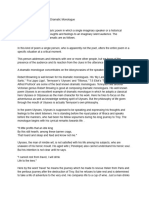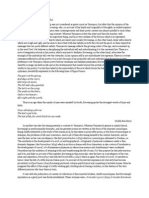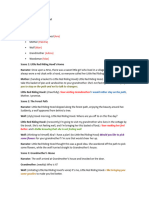T.S Eliot Life and Works
T.S Eliot Life and Works
Uploaded by
Lavenzel YbanezCopyright:
Available Formats
T.S Eliot Life and Works
T.S Eliot Life and Works
Uploaded by
Lavenzel YbanezOriginal Title
Copyright
Available Formats
Share this document
Did you find this document useful?
Is this content inappropriate?
Copyright:
Available Formats
T.S Eliot Life and Works
T.S Eliot Life and Works
Uploaded by
Lavenzel YbanezCopyright:
Available Formats
T.
S ELIOT LIFE AND WORKS:
Thomas Stearns Eliot was born in St. Louis, Missouri, on September 26, 1888. He lived
in St. Louis during the first eighteen years of his life and attended Harvard University . In
1910, he left the United States for the Sorbonne, having earned both undergraduate
and master’s degrees and having contributed several poems to the Harvard Advocate.
After a year in Paris, he returned to Harvard to pursue a doctorate in philosophy but
returned to Europe and settled in England in 1914. The following year, he married
Vivienne Haigh-Wood and began working in London, first as a teacher, and later for
Lloyd's Bank.
It was in London that Eliot came under the influence of his contemporary Ezra Pound,
who recognized his poetic genius at once, and assisted in the publication of his work in
a number of magazines, most notably "The Love Song of J. Alfred Prufrock" in Poetry in
1915.
With the publication of The Waste Land in 1922, now considered by many to be the
single most influential poetic work of the twentieth century,
Eliot's reputation began to grow to nearly mythic proportions; by 1930, and for the next
thirty years, he was the most dominant figure in poetry and literary criticism in the
English-speaking world.
As a poet, he transmuted his affinity for the English metaphysical poets of the
seventeenth century (most notably John Donne) and the nineteenth century French
symbolist poets (including Baudelaire and Laforgue) into radical innovations in poetic
technique and subject matter. His poems in many respects articulated the
disillusionment of a younger post–World War I generation with the values and
conventions—both literary and social—of the Victorian era.
As a critic also, he had an enormous impact on contemporary literary taste,
propounding views that, after his conversion to orthodox Christianity in the late thirties,
were increasingly based in social and religious conservatism.
He became a British citizen in 1927; long associated with the publishing house of Faber
& Faber, he published many younger poets, and eventually became director of the firm.
After a notoriously unhappy first marriage, Eliot separated from his first wife in 1933,
and remarried Valerie Fletcher in 1956. T. S. Eliot received the Nobel Prize for
Literature in 1948. He died in London on January 4, 1965.
ASH-WEDNESDAY
T. S. Eliot’s 1930 poem Ash-Wednesday needs to be viewed as part of the shift in
Eliot’s writing towards a more devotional aspect, a shift that would culminate in Four
Quartets (1943). The poem, like The Waste Land and ‘The Hollow Men’ before it, had
started life as shorter poems: Part II appeared in 1927, Part I in 1928, and Part III in
1929, with the other three sections being written around these. But the eventual six-part
poem is one of the finest modernist religious poems in English, although its content
requires some summary and analysis to be approachable and comprehensible.
Ash-Wednesday (note the hyphen) is perhaps, of all Eliot’s poems, the most heavily
indebted to Dante. Eliot would write more essays on Dante than on any other poet, and
the importance of Dante’s work to Eliot precedes his conversion to Christianity in 1927.
The Italian medieval poet is known for his three-part epic poem The Divine Comedy,
which describes the poet’s descent into the ‘inferno’ of hell, followed by his trip to
purgatory, culminating in his arrival in the ‘paradise’ of heaven. Two of Eliot’s most
famous earlier poems directly draw on Dante’s work: the epigraph to ‘The Love Song of
J. Alfred Prufrock’ is from the poet, while the lines about the ‘Unreal City’ of London in
The Waste Land (‘I had not thought death had undone so many’) are a loose translation
from Dante’s original Italian.
As well as parts of Dante’s Divine Comedy – which we might describe as a meditation
on Christianity – Eliot in Ash-Wednesday also draws on another poem by Dante, the
Vita Nuova (literally ‘New Life’), a collection of courtly love poems about idealised
beauty and its relation to religious faith. This is a key source for any analysis of the
importance of the feminine imagery in Ash-Wednesday, because it points up that Ash-
Wednesday is not just a religious poem, but also a love poem. However, it is about
spiritual love rather than worldly love – the female figures who appear in the poem, the
‘Lady’ and the ‘veiled sister’, are closer to versions of the Virgin Mary than they are to
any earthly woman. As well as Dante, there are also allusions to numerous other
sources, including Shakespeare’s sonnets (the line ‘Desiring this man’s gift and that
man’s scope’ is an adaptation of Shakespeare’s line ‘Desiring this man’s art and that
man’s scope’ from Sonnet 29), the Book of Common Prayer, and the poetry of
seventeenth-century Metaphysical (and devotional) poets such as John Donne and
George Herbert.
The poem’s subject is suggested obliquely by its title, Ash-Wednesday. Ash
Wednesday, the day after Shrove Tuesday in the Christian calendar, is the first day of
Lent, which is a period of forty days’ penance and fasting to commemorate the forty
days Christ spent fasting in the wilderness, where he was tempted by Satan and
triumphed over him. Traditionally, it’s a time for repentance for past sins. The ‘ash’
refers to the blessing of the ashes of palm branches (from the previous Sunday, Palm
Sunday), which are then marked on believers’ foreheads in a cross shape by the priest,
accompanied by the words ‘Remember that you are dust, and to dust you shall return’.
The theme of Ash-Wednesday, summarised in brief, is the turning away from the world
and towards God. Eliot had become increasingly dissatisfied with the ‘real world’ and
the sense of sickness and decay which he saw at the root of modern life: think about all
of the sterility and loss of spiritual meaning in The Waste Land, and then the hollowness
of ‘The Hollow Men’, caught in some in-between world. Modern life has lost its meaning
and its ‘edge’. Through religion, Eliot found a way to restore that meaning, and this is
what Ash-Wednesday is about. When he begins with talk of ‘turning’ (‘Because I do not
hope to turn again’), he is referring to this act of turning from the world and towards
God, from the real towards the spiritual – towards the message of Ash Wednesday. The
world is the desert, and God is the garden: the modern world is a deserted space, like
the space of ‘The Hollow Men’ or The Waste Land, while the garden – a world of growth
and life – is the world of God.
There seems to be an invitation to align this world, ‘The dreamcrossed twilight between
birth and dying’, with the ‘twilight kingdom’ in which the hollow men found themselves
trapped.
But where ‘The Hollow Men’ could offer nothing but despair, Ash-Wednesday – or, to be
more precise, the end of Ash-Wednesday – can restore meaning and joy to this ‘twilight’
world in which he find ourselves.
SOURCES:
https://poets.org/poet/t-s-eliot
https://www.poetryfoundation.org/poets/t-s-eliot
You might also like
- How To Interpret Dreams - A Biblical How-To Manual - v1 (Gary Fishman)Document54 pagesHow To Interpret Dreams - A Biblical How-To Manual - v1 (Gary Fishman)Joshua Poblete Directo100% (2)
- Adh QuotesDocument2 pagesAdh QuoteshappytingsNo ratings yet
- The Gruffalo (Julia Donaldson, 1999)Document5 pagesThe Gruffalo (Julia Donaldson, 1999)andreshostiaNo ratings yet
- The Metaphysical Poets Edited VersionDocument15 pagesThe Metaphysical Poets Edited VersionArgirios DourvasNo ratings yet
- John Milton's - LycidasDocument2 pagesJohn Milton's - Lycidasravitejas978100% (1)
- Thomas Gray: Transitional PoetDocument24 pagesThomas Gray: Transitional PoetAmäl HåmDy100% (1)
- Assignment#3 (Heart of Darkness)Document3 pagesAssignment#3 (Heart of Darkness)Info GroupNo ratings yet
- 'Ulysses' by Tennyson As A Dramatic MonologueDocument2 pages'Ulysses' by Tennyson As A Dramatic Monologuex.joelgladson100% (1)
- Wordsworth - The PreludeDocument18 pagesWordsworth - The PreludeSudhansu pandaNo ratings yet
- LiteratureDocument2 pagesLiteratureAnamika Rai Pandey100% (1)
- Honest Criticism and Sensitive Appreciation Is Directed Not Upon The Poet But Upon The Poetry.Document6 pagesHonest Criticism and Sensitive Appreciation Is Directed Not Upon The Poet But Upon The Poetry.Jimmi Khan100% (1)
- English Literature - Preface To Lyrical Ballads - WordsworthDocument9 pagesEnglish Literature - Preface To Lyrical Ballads - WordsworthShubhaiyu Chakraborty100% (1)
- The Nature of The Linguistic Sign by SaussureDocument6 pagesThe Nature of The Linguistic Sign by Saussurebfh88j18100% (1)
- AmbulanceDocument2 pagesAmbulancepari gul100% (1)
- Mahesh Dattani's Seven Steps Around The Fire: Breaking The StereotypesDocument3 pagesMahesh Dattani's Seven Steps Around The Fire: Breaking The StereotypesIJELS Research JournalNo ratings yet
- After The FuneralDocument2 pagesAfter The Funeralimuias0% (1)
- Robert Browning A Dramatic MonologueDocument2 pagesRobert Browning A Dramatic MonologueArindam SenNo ratings yet
- The Inscrutable AmericansDocument2 pagesThe Inscrutable AmericansPadma TotaNo ratings yet
- Kaleidoscope of Themes in Indian Writing in EnglishDocument10 pagesKaleidoscope of Themes in Indian Writing in EnglishAravind KazakNo ratings yet
- !! Absalom and AchitophelDocument2 pages!! Absalom and AchitophelArohe Roy Lazz0% (1)
- Past Paper of Criticism 2004 To 2019Document28 pagesPast Paper of Criticism 2004 To 2019Noor UlainNo ratings yet
- William Butler Yeats As A Representative Poet of Modern AgeDocument2 pagesWilliam Butler Yeats As A Representative Poet of Modern AgeJuma GullNo ratings yet
- Chief Characteristics of Dryden As A CriticDocument4 pagesChief Characteristics of Dryden As A CriticQamar KhokharNo ratings yet
- Final SolutionsDocument9 pagesFinal SolutionsNeha PatialNo ratings yet
- THEMES-Metaphysical PoetryDocument3 pagesTHEMES-Metaphysical PoetryLaura GabrielaNo ratings yet
- A Dialogue of Self and SoulDocument4 pagesA Dialogue of Self and SoulAwais TareqNo ratings yet
- A Prayer For My Daughter WB YeatsDocument5 pagesA Prayer For My Daughter WB YeatsTinku ChoudharyNo ratings yet
- Elements of Exile and Alienation in R. Parthasarathy's Poem: 'Trial'Document8 pagesElements of Exile and Alienation in R. Parthasarathy's Poem: 'Trial'anjuNo ratings yet
- DickinsonDocument4 pagesDickinsonAnna Maracine100% (1)
- Dissociation of SensibilityDocument7 pagesDissociation of SensibilityotherthannomadologyNo ratings yet
- Neo ClassicalDocument4 pagesNeo ClassicalMeredith LloydNo ratings yet
- Final The Famished RoadDocument10 pagesFinal The Famished RoadEdinNo ratings yet
- Seamus HeaneyDocument22 pagesSeamus HeaneyMaida Rana0% (1)
- WordsworthDocument3 pagesWordsworthMandyMacdonaldMominNo ratings yet
- Larkin Ambulances1Document4 pagesLarkin Ambulances1Sumaira MalikNo ratings yet
- Literary Characteristics of Puritan AgeDocument16 pagesLiterary Characteristics of Puritan AgeMaria Rani100% (1)
- Tragic FlawDocument2 pagesTragic FlawRaqibul Islam TanizNo ratings yet
- Lecture - 8 Preface To Fables Dryden Evaluation of ChaucerDocument4 pagesLecture - 8 Preface To Fables Dryden Evaluation of Chaucersakura yuimikoNo ratings yet
- Room of One's Own and CustodyDocument10 pagesRoom of One's Own and CustodyDushyant NimavatNo ratings yet
- AllegoryDocument4 pagesAllegoryuptagrafftreneauNo ratings yet
- LITERARY CRITICISM AnswersDocument5 pagesLITERARY CRITICISM Answersmahnoor khanNo ratings yet
- All For Love: John DrydenDocument7 pagesAll For Love: John DrydenAmritendu MaitiNo ratings yet
- "Dream Children - A Reverie" by Charles LambDocument4 pages"Dream Children - A Reverie" by Charles LambDaleep Kumar100% (1)
- Assignment On 'The Trial'Document18 pagesAssignment On 'The Trial'satanshis100% (1)
- An Essay On Dramatic PoesyDocument13 pagesAn Essay On Dramatic PoesyNisar AhmedNo ratings yet
- A Reading of T.S.Eliot's Ash-Wednesday1Document22 pagesA Reading of T.S.Eliot's Ash-Wednesday1Asaf Abramovich100% (1)
- Donne As A Metaphysical PoetDocument4 pagesDonne As A Metaphysical PoetAsadNo ratings yet
- Midnight S Children A Postcolonial Criti PDFDocument13 pagesMidnight S Children A Postcolonial Criti PDFfreddieNo ratings yet
- Character of LucreziaDocument2 pagesCharacter of LucreziaHeart Broken100% (1)
- Aristotle's Poetics-Six Parts of TragedyDocument15 pagesAristotle's Poetics-Six Parts of TragedyKa liNo ratings yet
- As A RefutationDocument2 pagesAs A RefutationSaleem Raza100% (1)
- Question - How Does Eliot Distinguish Between - Unitication of Sensibility and Dissociation of Sensibility - in The Metaphysical PoetsDocument7 pagesQuestion - How Does Eliot Distinguish Between - Unitication of Sensibility and Dissociation of Sensibility - in The Metaphysical PoetsMuhammad Rakibulislam100% (1)
- The Pot of GoldDocument15 pagesThe Pot of GoldKrishna MukherjeeNo ratings yet
- Short Fictional NarrativeDocument9 pagesShort Fictional Narrativezaima zahidNo ratings yet
- Essay On Dramatic Poesy Part22Document7 pagesEssay On Dramatic Poesy Part22Ebrahim Mohammed AlwuraafiNo ratings yet
- Walt Whitman As Amystic PoetDocument2 pagesWalt Whitman As Amystic PoetNauman MashwaniNo ratings yet
- The Hound of The Baskervilles - A Critical StudyDocument3 pagesThe Hound of The Baskervilles - A Critical StudySAGNIKNo ratings yet
- Browing Dramatic MonolgueDocument3 pagesBrowing Dramatic MonolgueJaved Gunjial100% (1)
- Mourning Becomes ElectraDocument12 pagesMourning Becomes ElectraImran Anwar100% (1)
- WhitmanDocument61 pagesWhitmanhashemdoaaNo ratings yet
- Cheif Characteristics of Dryden As Critic PresentationDocument30 pagesCheif Characteristics of Dryden As Critic PresentationQamar KhokharNo ratings yet
- Topic 1: Simple Stress: Mechanics of Deformable BodiesDocument26 pagesTopic 1: Simple Stress: Mechanics of Deformable BodiesLavenzel YbanezNo ratings yet
- (Ybañez) Mission-AnimationDocument2 pages(Ybañez) Mission-AnimationLavenzel YbanezNo ratings yet
- IMPROMPTUDocument1 pageIMPROMPTULavenzel YbanezNo ratings yet
- Mr. Ken Opina: Performance Task in Compliance With Our Disciplines and Ideas in The Applied SocialDocument1 pageMr. Ken Opina: Performance Task in Compliance With Our Disciplines and Ideas in The Applied SocialLavenzel YbanezNo ratings yet
- (Ybanez) Educ Lesson PlannnDocument2 pages(Ybanez) Educ Lesson PlannnLavenzel YbanezNo ratings yet
- Cultural Factors Influencing SLADocument11 pagesCultural Factors Influencing SLALavenzel YbanezNo ratings yet
- Ybañez, Lavenzel Niña A. BSED - ENGL 2 ED ENG 2102Document5 pagesYbañez, Lavenzel Niña A. BSED - ENGL 2 ED ENG 2102Lavenzel YbanezNo ratings yet
- Contemporary Literature Activity: Comic, Graphic Novel, and MangaDocument2 pagesContemporary Literature Activity: Comic, Graphic Novel, and MangaLavenzel YbanezNo ratings yet
- Ybañez (ASS LANG. POLICY)Document2 pagesYbañez (ASS LANG. POLICY)Lavenzel YbanezNo ratings yet
- Dream On: BY: Lavenzel Niña A. YbañezDocument10 pagesDream On: BY: Lavenzel Niña A. YbañezLavenzel YbanezNo ratings yet
- What Are Demands of 21st Century Skills?Document3 pagesWhat Are Demands of 21st Century Skills?Lavenzel Ybanez100% (1)
- Bibliography: Opening' - Retrieved May 21, 2020, From Manila BulletinDocument1 pageBibliography: Opening' - Retrieved May 21, 2020, From Manila BulletinLavenzel YbanezNo ratings yet
- Learning Styles: 2.90 3.00 2.91 MeanDocument6 pagesLearning Styles: 2.90 3.00 2.91 MeanLavenzel YbanezNo ratings yet
- 2ND BATCH SourcesDocument1 page2ND BATCH SourcesLavenzel YbanezNo ratings yet
- Kalaw, Maximo Manguiat (1926) - The Development of Philippine Politics, 1872-1920. Manila: Oriental Commercial CoDocument1 pageKalaw, Maximo Manguiat (1926) - The Development of Philippine Politics, 1872-1920. Manila: Oriental Commercial CoLavenzel YbanezNo ratings yet
- Immaculate: Heart of Mary AcademyDocument3 pagesImmaculate: Heart of Mary AcademyLavenzel YbanezNo ratings yet
- Asset Calendar 2019Document1 pageAsset Calendar 2019Lavenzel YbanezNo ratings yet
- Immaculate: Heart of Mary AcademyDocument2 pagesImmaculate: Heart of Mary AcademyLavenzel YbanezNo ratings yet
- Stories in CanterburyDocument21 pagesStories in CanterburyLavenzel YbanezNo ratings yet
- Grade 6 - PEDocument2 pagesGrade 6 - PELavenzel YbanezNo ratings yet
- TS Eliot RepoooortDocument22 pagesTS Eliot RepoooortLavenzel YbanezNo ratings yet
- BAIRD Man With The FlowerDocument9 pagesBAIRD Man With The FlowerLavenzel YbanezNo ratings yet
- Japanese PhrasesDocument1 pageJapanese PhrasesLavenzel YbanezNo ratings yet
- George Herberts The Temple A Religious Rhyme or P PDFDocument10 pagesGeorge Herberts The Temple A Religious Rhyme or P PDFLavenzel YbanezNo ratings yet
- New German Critique No 49 Special Issue On Alexander Kluge 1990Document196 pagesNew German Critique No 49 Special Issue On Alexander Kluge 1990ziggy00zaggy100% (1)
- Footprints by Denise LervertovDocument6 pagesFootprints by Denise LervertovNat RogersNo ratings yet
- 20 Important Quotations ExplainedDocument5 pages20 Important Quotations Explainedletusconvertvideos100% (1)
- Look at Six Sentences For This Part. The Statement (E.g. D, Agrees, Persuades BecauseDocument8 pagesLook at Six Sentences For This Part. The Statement (E.g. D, Agrees, Persuades BecauseJohn Boston100% (1)
- Caperucita Roja Ingles COMPUESTO 1Document3 pagesCaperucita Roja Ingles COMPUESTO 1elrandom447No ratings yet
- 012 Song Lyrics and WorksheetsDocument18 pages012 Song Lyrics and WorksheetsSofiene GuedriNo ratings yet
- Stern Mba EssaysDocument4 pagesStern Mba Essaysajdegacaf100% (2)
- Cornell Notes Fiction 5Document2 pagesCornell Notes Fiction 5api-329035384No ratings yet
- Indian Literature Oral Literary Tradition in IndiaDocument1 pageIndian Literature Oral Literary Tradition in IndiaAnurag UpadhyayNo ratings yet
- Lovely H. Pacheco NSTP - CWTS 15 Mrs. Lydia Fadol 08/24/19Document2 pagesLovely H. Pacheco NSTP - CWTS 15 Mrs. Lydia Fadol 08/24/19LovelyNo ratings yet
- ? Bungou Stray Dogs MBTI Personality Types 11Document1 page? Bungou Stray Dogs MBTI Personality Types 11comayiroeltraviesoNo ratings yet
- Love Spells That Work Fast and ImediatelyDocument14 pagesLove Spells That Work Fast and ImediatelyNguyen0% (5)
- Kotsu Kagemori BackstoryDocument2 pagesKotsu Kagemori Backstorybatmansigma68No ratings yet
- Ensayos de Emily DickinsonDocument7 pagesEnsayos de Emily Dickinsonoppfvxmpd100% (1)
- Inthe Timeofthe Butterflies QuestionsDocument1 pageInthe Timeofthe Butterflies QuestionsLori RobinsonNo ratings yet
- Women Poem 1Document10 pagesWomen Poem 1stellathobeiNo ratings yet
- Задания 9-11 классы PDFDocument19 pagesЗадания 9-11 классы PDFNguyễn Ngọc MinhNo ratings yet
- Goethe, Kant and Intuitive Thinking in Rudolf Steiner's POF PDFDocument28 pagesGoethe, Kant and Intuitive Thinking in Rudolf Steiner's POF PDFChitchai P-chaloempongNo ratings yet
- Byzantine CalendarDocument16 pagesByzantine CalendarFilip100% (1)
- List of Important Synonyms: The Top 250 Most Difficult SAT WordsDocument19 pagesList of Important Synonyms: The Top 250 Most Difficult SAT WordsTahir HanifNo ratings yet
- Return To Nature A Study of Tintern AbbeDocument2 pagesReturn To Nature A Study of Tintern AbbeAbdullah HamzaNo ratings yet
- Baudelaire Charles-Las Flores Del Mal PDFDocument490 pagesBaudelaire Charles-Las Flores Del Mal PDFMaría UgaldeNo ratings yet
- Legend of Old DochiaDocument5 pagesLegend of Old DochiaellaprincessellaNo ratings yet
- Complete InsufferableDocument442 pagesComplete InsufferableSteven GunninNo ratings yet
- 5 Poems: National Artists For Literature Jose Garcia Villa Edith L. Tiempo Cirilo Bautista Nick JoaquinDocument15 pages5 Poems: National Artists For Literature Jose Garcia Villa Edith L. Tiempo Cirilo Bautista Nick JoaquinMaravilla JayNo ratings yet
- What Bakwas YaDocument1 pageWhat Bakwas Yajayadityasingh.kNo ratings yet
- EDRADAN - Japanese LiteratureDocument5 pagesEDRADAN - Japanese LiteratureFriedrich Carlo Jr. EdradanNo ratings yet
- Charlie and The Chocolate Factory (Synopsis)Document3 pagesCharlie and The Chocolate Factory (Synopsis)sin wai BeeNo ratings yet

















































































































